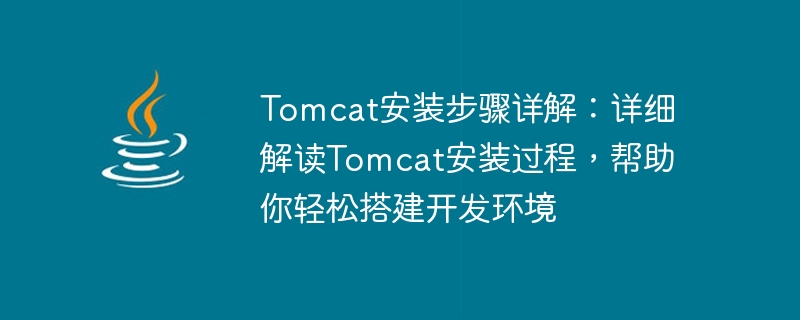

Detailed explanation of Tomcat installation steps
Tomcat is an open source web application server. It is a core project in the Jakarta project of the Apache Software Foundation. Tomcat is developed using Java language, supports Servlet and JavaServer Pages technology, and is widely used to develop and deploy Java Web applications.
This article will explain the installation process of Tomcat in detail to help you easily set up a development environment. The following are specific installation steps.
Step 1: Download Tomcat
First, you need to download the latest Tomcat installation package from the Tomcat official website (https://tomcat.apache.org). Choose the appropriate version according to your system environment. There are usually two versions: Windows and Linux.
Step 2: Unzip the installation package
After the download is complete, unzip the installation package to the directory where you want to install Tomcat. After unzipping, you will get a folder named apache-tomcat-x.x.x (x is the version number).
Step 3: Configure environment variables
Before installing Tomcat, make sure that the Java environment variables have been correctly configured. Add the Java installation path (for example, C:Program FilesJavajdkx.x.x in) to the system's PATH environment variable so that you can run Java commands from anywhere.
Step 4: Start Tomcat
Open the command line window and enter the Tomcat installation directory (apache-tomcat-x.x.x/bin). Execute the following command to start Tomcat:
Windows system:
startup.bat
Linux system:
./startup.sh
Tomcat will start and Display relevant log information in the command line window.
Step 5: Verify the installation result
Open a web browser and enter the following address to verify whether Tomcat starts successfully:
http://localhost:8080
If you see the Tomcat welcome page, it means that Tomcat has been successfully installed and running normally.
Step 6: Deploy Web Application
To deploy your own Web application, package your application into a WAR file, and then copy the WAR file to Tomcat's webapps directory. Tomcat will automatically decompress the WAR file and deploy the application to the specified directory.
The following is a simple example, assuming your application is a folder named myapp:
After completing the above steps, your web application will be accessible at the following URL:
http://localhost:8080/myapp
Step 7 : Configure Tomcat
In the Tomcat installation directory, there is a folder named conf, which contains the Tomcat configuration file. You can modify these configuration files as needed to meet your specific needs.
The most common configuration files are server.xml and web.xml, which are used to configure the Tomcat server and Web applications respectively. Before interpreting these configuration files, please make sure you understand Tomcat's configuration syntax and related parameters.
Step 8: Shut down Tomcat
When you no longer need the Tomcat server, you can shut down Tomcat through the following command:
Execute the following command in the command line window:
Windows system:
shutdown.bat
Linux system:
./shutdown.sh
Tomcat will be shut down and the related shutdown will be displayed in the command line window log.
Through the above eight steps, you can easily install and configure Tomcat and build a powerful Java Web development environment. I hope this article can be helpful to you, and I wish you success in the world of Tomcat!
The above is the detailed content of Easily set up a development environment: in-depth analysis of Tomcat installation steps to help you install Tomcat smoothly. For more information, please follow other related articles on the PHP Chinese website!
 How to configure Tomcat environment variables
How to configure Tomcat environment variables
 How to integrate idea with Tomcat
How to integrate idea with Tomcat
 How to view Tomcat source code
How to view Tomcat source code
 What are the common tomcat vulnerabilities?
What are the common tomcat vulnerabilities?
 How to solve garbled tomcat logs
How to solve garbled tomcat logs
 What are the differences between weblogic and tomcat
What are the differences between weblogic and tomcat
 What are the differences between tomcat and nginx
What are the differences between tomcat and nginx
 How to solve tomcat startup crash
How to solve tomcat startup crash




